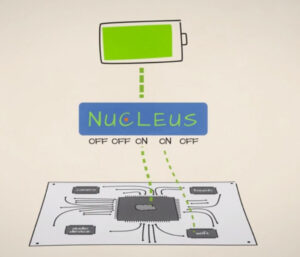 Mentor Graphics Corporation today announced the Nucleus real-time operating system (RTOS) support for the 64-bit ARMv8-A architecture. This architecture support enables the Nucleus RTOS to leverage the benefits of 64-bit processing for a full range of 64-bit SoCs. The Nucleus RTOS also enables the ARMv8-A aarch32 (32-bit) execution mode that allows users to run legacy 32-bit code on 64-bit SoCs. This support for ARMv8-A SoCs capability enables device manufacturers to develop leading-edge products for markets including automotive, industrial, medical, mil/aero and networking.
Mentor Graphics Corporation today announced the Nucleus real-time operating system (RTOS) support for the 64-bit ARMv8-A architecture. This architecture support enables the Nucleus RTOS to leverage the benefits of 64-bit processing for a full range of 64-bit SoCs. The Nucleus RTOS also enables the ARMv8-A aarch32 (32-bit) execution mode that allows users to run legacy 32-bit code on 64-bit SoCs. This support for ARMv8-A SoCs capability enables device manufacturers to develop leading-edge products for markets including automotive, industrial, medical, mil/aero and networking.
The initial Nucleus reference implementation is for the NXP QorIQ LS2085A-RDB Reference Design Board. Device support exists for kernels including NEON, Nucleus Process Model, CPU and UART. Device support can easily be extended by the customer or by Mentor Embedded professional services. This architecture port can also support related SoCs such as NXP’s QorIQ LS2080A/40A, LS2045A, LS2084/44A, LS2088A/48A, LS1012A, LS1046A/26A, LS1043A/23A, and LS1088A/48A processors.
“Mentor Graphics continues to demonstrate embedded software leadership, complementing NXP’s advantages in offering high-performance ARMv8-A SoCs,” said Noy Kucuk, Vice President, Product Management for NXP Semiconductors’ Digital Networking Business Line. “With 64-bit Nucleus RTOS support for NXP QorIQ communication processors, our joint customers can develop smarter and more capable devices with a proven commercial real-time operating system solution.”
ARMv8-A support for the Nucleus RTOS is included with the Nucleus ReadyStart product, which provides developers the Eclipse-based Sourcery CodeBench IDE development environment and complete source code that enables embedded developers to quickly get their products to market.
The Sourcery CodeBench IDE is an embedded development platform that comes with ARM DSTREAM support for NXP’s QorIQ LS2085 device and a prebuilt, hardened, and supported GNU compiler collection (GCC) toolchain. The toolchain comes bundled with both aarch64 and aarch32 multilibs providing flexibility and choice to end users when working with ARMv8-A-based processors. The Sourcery Codebench tool includes the Sourcery Analyzer technology, a powerful embedded design analysis solution combining unique profiling and analysis engine with data visualization capabilities.
The Nucleus product is a rich, hard-real-time, low-footprint, highly scalable RTOS that makes high-end features available to the embedded market without compromising simplicity and compactness of the solution. At the core, the Nucleus RTOS comes enabled with multicore technologies such as SMP and the Mentor Embedded Multicore Framework, and supports USB 3.0, PCI Express and the TI WiLink 8 stack. This makes it a unique offering in the embedded market.
The Nucleus Process Model (NPM) is a lightweight process model enabling task and library isolation. It also provides memory protection to gain significant increases in product reliability due to faster isolation of software faults, and the ability of deployed systems to self-diagnose. Further, this enables dynamic loading and unloading of processes making it highly extensible at runtime.
Embedded developers can also take advantage of the built-in Nucleus Power Management Framework. Developers specify application requirements with high-level hardware-agnostic APIs, and the Nucleus RTOS automatically discovers power-aware components to help simplify the design process, increase code reuse, and speed time to market.
The post ARMv8-A support enables Nucleus RTOS to leverage processing benefits of 64-bit SoCs appeared first on Microcontroller Tips.

